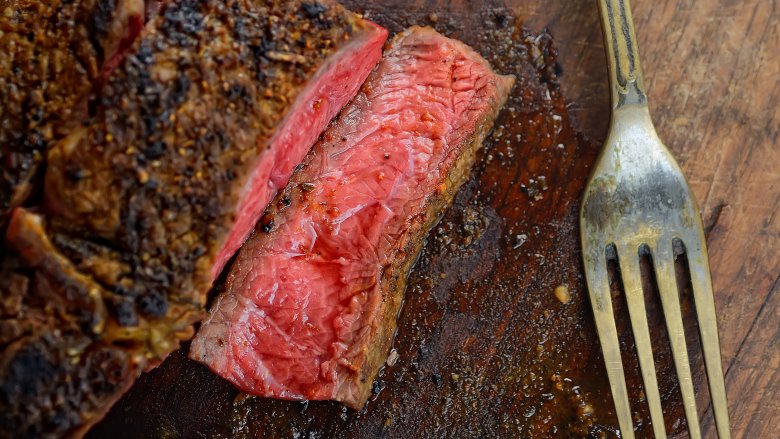Here's What The 'Blood' In Steak Really Is
Whether shopping for pork chops in your supermarket's meat aisle, or slicing into a New York strip cooked on the rare side, you'll probably notice some reddish liquid oozing from the cut of meat. It's red, so it has to be blood, right? What else could it possibly be? If the thought of biting into a bloody steak is a little unappetizing, fear not — that's not actually blood seeping out of your $30 filet mignon.
No, it turns out that "blood" is actually water mixed with myoglobin. Myoglobin is a protein rich in iron that delivers oxygen to an animal's muscles. When the iron is hit with oxygen, it turns the myoglobin red (via The New York Times). Lamb, pork, and beef have higher amounts of myoglobin in their tissue than other animals, which is where we get the term "red meat."
You might also have noticed while browsing through your local butcher shop that the meat of pork or veal is more of a pinkish color than compared with most cuts of beef. Again, this all has to do with the amount of myoglobin in the meat. According to Meat News Network (no, we didn't make that up) pork and veal are harvested at a younger age than most beef. "As that animal gets older, they're going to develop more myoglobin," Gregg Rentfrow Ph.D. of the University of Kentucky said.
Of course, once that meat goes onto the grill or into the oven, the heat creates a chemical process that turns it anywhere from a pinkish color with a bright red center to more of a brown color. It all depends on the amount of heat that hits the meat (via Food Republic).
Now that you know that red liquid isn't blood, but myoglobin leaking out of your steak, where is the actual blood in the meat? "Once the animal is humanely stunned, the blood is removed quickly thereafter," Rentfrow said. "Within probably 30 to 40 seconds or so." This is done in accordance with USDA law. According to Pusheta Creek Steaks, after the slaughter processs, "very little blood remains in the muscle tissue."
Hopefully this offers a little peace of mind next time you're asked if you want your steak "bloody."
